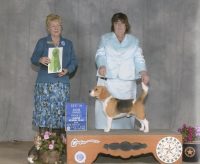 The Beagle is one of the most popular and well-known dog breeds. It was the inspiration for the character Snoopy and featured in the works of William Shakespeare. They are part of the Hound Group. Not everyone knows this, but the purebred Beagle actually comes in two size variants. This guide will look at the differences between Beagle size as well as the general standards for the breed.
The Beagle is one of the most popular and well-known dog breeds. It was the inspiration for the character Snoopy and featured in the works of William Shakespeare. They are part of the Hound Group. Not everyone knows this, but the purebred Beagle actually comes in two size variants. This guide will look at the differences between Beagle size as well as the general standards for the breed.
Breed Origin
Dogs resembling the Beagle breed have been around for well over 2,500 years, as far back as Ancient Greece. Their ancestors were brought to England with William the Conqueror and were very popular in medieval times. The modern breed was developed in the mid-1800s in England.
The Differences In Beagle Size
Beagles come in two different size categories. These are commonly known as the 13-inch (or 33 cm) Beagle and the 15-inch (or 38 cm) Beagle, with height measured at the withers. The American Kennel Club recognizes both size variants, although any Beagle over 15 inches will be disqualified from official AKC shows. The UK Kennel Club and some other organizations only recognize one type of Beagle, with a height of between 13 and 16 inches (or 33 and 41 cm).
Historically, Beagles were larger than their modern breed, though they have since shrunk to their modern, smaller sizes. There were also Pocket Beagles, which had breed standards as late as 1901 and were kept by Queen Elizabeth I. They stood 8 to 9 inches (or 20 to 23 cm). It was said that sometimes hunters would carry this diminutive variant in their coats as they hunted on foot. Some modern breeders have attempted to recreate Pocket Beagles, although this variety is not recognized by any official kennel club.
The Differences In Beagle Weight
The 13-inch Beagle size generally weighs less than the 15-inch Beagle size due to the simple difference in stature. Males are generally larger and heavier than females. The AKC standard is under 20 pounds (around 9 kg) for the 13-inch Beagle size, and 20-30 pounds for Beagles between 13 and 15 inches.
Breed Standard
The breed standard between the two sizes is otherwise the same. The standard and what is or is not acceptable in a show animal obviously varies slightly depending on the organization running the show. Physical characteristics of the Beagle include large brown or hazel eyes and a smooth, domed skull.
A variety of colors are acceptable. The so-called tricolor Beagle, which is white, black and brown, is the most common and well-recognized. Tricolored Beagles can come in a variety of shades. For two-colored Beagles, tan and white is the most common combination. Other colors a Beagle can be include lemon, red, blue and a reddish brown that is almost orange. Liver is possible but not common, and the color is not accepted in some standards. There are also ticked or mottled varieties.
For Owners Considering A Beagle
Because of their smaller size, cute appearance and charming personalities, the Beagle is an extremely popular dog breed – ranked fifth in popularity by the AKC. Beagles are happy, friendly, curious dogs. Like most hounds, they are rather vocal and known for their trademark bay. They also have one of the most advanced senses of smell of any breed, after the Bloodhound and the Basset Hound.
They were bred to hunt. Because of this, they are high energy dogs and need significant amounts of exercise. Many owners do not give them the exercise they need and so they become overweight, which is a common issue with the breed and leads to health problems. Beagles need a fenced-in yard they can run around in, and because they are little escape artists the enclosure must be very secure.
While spaying or neutering a dog is still the recommended practice for most owners, more veterinarians are agreeing that it is not a one-size-fits-all procedure. For example, it may be best to forgo alteration for Beagles that will hunt or participate in canine athletics. Dogs that will participate in official shows also cannot be altered.
As a smaller breed of dog, Beagles tend to live longer than larger breeds, at around 12-15 years. As with most purebred dogs, the Beagle has a few known health problems although it is a generally healthy breed. Deafness, patellar luxation, epilepsy and glaucoma are some of the more common ailments to watch out for. Finding a reputable breeder is paramount to ensure a Beagle pup has been responsibly bred. The National Beagle Club is the official club for this breed in the United States.
 Small dogs are growing in popularity as companions, and more miniature versions of your favorite breeds are becoming available including Pocket Beagles. These feisty miniature versions of Beagles have the same attributes but are more suitable for apartment living for those who don’t have a lot of land. They are friendly and easy to groom and make a great family pet.
Small dogs are growing in popularity as companions, and more miniature versions of your favorite breeds are becoming available including Pocket Beagles. These feisty miniature versions of Beagles have the same attributes but are more suitable for apartment living for those who don’t have a lot of land. They are friendly and easy to groom and make a great family pet. There are many reasons to adopt a beagle. The breed is friendly, energetic and loves to be around people. In contrast to all of these positive traits, beagles tend to be a bit stubborn. The best way to minimize this headstrong tendency is by implementing beagle training methods immediately after adopting your dog. Here are some breed-specific tips to help eliminate common inappropriate behaviors.
There are many reasons to adopt a beagle. The breed is friendly, energetic and loves to be around people. In contrast to all of these positive traits, beagles tend to be a bit stubborn. The best way to minimize this headstrong tendency is by implementing beagle training methods immediately after adopting your dog. Here are some breed-specific tips to help eliminate common inappropriate behaviors.






